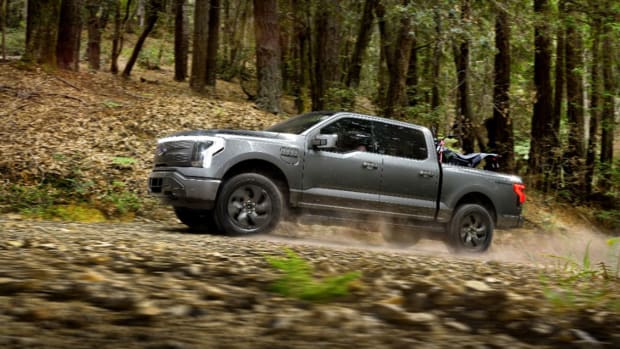
Ford has a recipe that works.
The legacy carmaker has bet on the development of electric versions of its emblematic gas car models.
It currently has three models: the Ford Mustang Mach-E crossover/SUV, the F-150 Lightning pickup/truck and the e-Transit van. Each targets a distinct customer base and -- hugely important -- all three vehicles are in market segments with lucrative profit margins. Other models will be added to these three in the next few years.
Ford wants to produce EVs at an annual rate of 600,000 by late 2023, and more than 2 million by 2026.
The returns on this strategy are looking good, as Ford is ramping up efforts to boost the production of the F-150 Lightning. Less than seven months after the start of production, the Dearborn, Mich., group has added a third production shift in the Michigan plant in charge of assembling this model.
The plant is now running three rotating crews of workers on 10-hour shifts seven days a week, Corey Williams, plant manager of the Dearborn Truck Plant and Rouge electric vehicle center, told CNBC during a tour of the facility on Dec. 13.

Ford
Ford Factory Expansion
The company wants to maintain a high level of production even as construction workers scramble to complete an expansion of the facility.
“That’s how we’re doing this fast. We’re building product while building out the factory," Williams said.
The plant's workforce has increased to 750 employees, from 500 previously. It's an increase of 50%.
The move is part of Ford's ambition to produce 150,000 units of the F-150 Lightning per year by mid-2023 to satisfy the strong consumer demand, the company said last January.
Ford delivered 13,258 F-150 Lightning trucks through the end of November.
Initially, Ford only planned to produce 40,000 units per year of the F-150 Lightning. This caution was due to several factors that the group never revealed. But analysts have always speculated on the recharging of the battery, especially in the heart of America where few stations exist for the moment, as a potential obstacle for the adoption of the F-150 Lightning.
Many electric vehicle buyers have run out of juice, only to find that the station they saw online in Google Maps was for a completely different charging apparatus.
Mostly, though, possible business and agricultural buyers would like to make sure the electric version of the F-150 was just as tough and was able to complete its tasks without constantly needing a long, time-consuming charge, experts thought.
But Ford had said that the truck will have a range of between 230 miles and 320 miles, depending on the model. All versions of the Lightning can be connected to the Blue Oval Charge Network, a string of 70,000 chargers throughout North America maintained by Ford.
Each charger on the Blue Oval network can add about 54 miles of range per 10 minutes of charge, and it comes with an app that allows you plan your trip around where the neared chargers are located.
The Lightning also can be charged at home.
Fierce Competition Ahead
The F-150 Lightning is on the rise. The vehicle has just been crowned Truck of the Year by MotorTrend. This is the second consecutive year that the award goes to an electric vehicle, rather than a traditional pick-up truck. Last year, the award was given to the Rivian (RIVN) R1T.
"Electric pickup trucks to date have all been lifestyle vehicles aimed at people with a lot of disposable income to spend on outdoorsy hobbies," MotorTrend said when announcing the winner. "In building an EV truck that looks just like any other gas- or diesel-powered pickup on the market, Ford gambled traditional truck customers will be more receptive to the kind of pickup they're familiar with and have relied on for years."
Currently, the main competitors of the F-150 Lightning are the Rivian RT1 and the electric version of the iconic Hummer. But in a few months, the competition will become fierce with the electric version of the Chevrolet Silverado (GM) and the highly anticipated Cybertruck from Tesla (TSLA).







